Apr 11, 2025

There can be up to 1 billion bacteria and 1 million fungi in a teaspoon of topsoil. But, this number can be misleading when it comes to farm soil. Even if there are over a billion microbes in a teaspoon of your soil, 75% of those microbes can be dormant and too weak to do the work they normally do for soil and crops.
Why?
Mainly because they’re starving, but there are lots of other reasons on top of a lack of a nutritious food supply that your soil microbiome may be struggling. Tillage, fertilizer and monocropping all have a negative impact on your soil microbe community. When your soil and your crops don’t have the support from beneficial microbes, you’re forced to work against nature, rather than with it.
Soil microbes have a powerful impact on soil, ecosystems and yield potential.
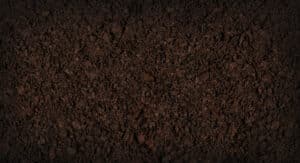
Soil microbes are microscopic organisms that live in your soil. They are mostly fungi and bacteria, but there are also archaea, protozoa, viruses, and more. Soil microbes interact with other organisms living in the soil, the soil itself and plant roots.
These microbes can be pathogenic or beneficial to your soil and crop health. Pathogenic microbes can cause disease and compete for nutrients with beneficial microbes.
Beneficial microbes, on the other hand, greatly improve soil health, quality and structure. In fact, 80-90% of soil processes are impacted by the soil microbiome. Some of the processes include carbon sequestration, nutrient cycling and the formation of soil structure.
Like any organism, they need food and water for survival, so soil microbes gather around areas like plant roots that provide them with exudates, or other organic matter deposits. This area is known as the rhizosphere. The diversity and abundance of the microorganisms in soil is primarily determined by:
Diversity and abundance of soil microbes are both needed to support farms, as higher abundance and diversity increases the likelihood of microbes performing positive functions, regardless of conditions.

Active, abundant and diverse microbes are essential for improved plant health and increased yield potential. Due to the fact that beneficial microbes live so close to plant roots, they have a great opportunity to impact crop health.
Some of the benefits for your crops include:
An active microbiome can also increase a plant root’s ability to access nutrients and water in the soil.
Each subspecies of microbe has its own unique benefits, too. For example, rhizobia, in particular, have a special symbiotic relationship with legume roots. They form a nodule structure on the root where colonies of bacteria convert atmospheric nitrogen to ammonia that can be used by the plant.
Bacteria secrete extracellular polymeric substances (EPS), or glues, that stick together sand, silt, and clay particles to stabilize microaggregates. These glues improve soil structure and benefit your crop’s root system.
Fungi use their hyphae to create a web around particles in a net like structure to tie the soil together, with both nets and glues, soil structure and aggregation is improved. Mycorrhizal fungi create symbiotic relationships with plant roots that aids in moving nutrients and water from areas of excess to areas of need to support the crops in their network.
In more ways than one, active beneficial microbes help maintain soil health to improve crop performance. And, soil microbes also play a significant role in supporting your soil.
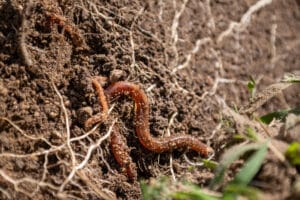
Beneficial soil microbes play an important role in supporting soil health, quality and structure.
By soil health, we mean the biological integrity of your soil support plant growth. Farm soil is a mixture of minerals, organic matter, water and pores. Soil organic matter includes all carbon based materials in your soil, including living and non-living organisms.
By soil quality, we mean the physical, biological and chemical makeup of your soil. how well your soil does its job, e.g crop production.
By soil structure, we mean the size and arrangement of soil particles (aggregates) that create pore space for water, nutrients, gasses and other organisms. Here are some of the ways beneficial microbes contribute to maintaining soil health:
Also, after the ocean, our soil is the second largest carbon sink. And, as the most basic level of the food chain, a lack of soil microbes can disrupt everything else in your farm’s ecosystem.
For a long time, growers were prescribed many of the actions below as a best practice for increasing short-term yield potential. Unfortunately, these best practices came with long-term damage to soil health and the microbiome.
At its worst, these practices create an unbalanced ecosystem with deteriorating soil health. Often, the fix for the problems these practices create is to repeat them, trapping growers in a never-ending investment cycle.
Tillage, monocropping and excessive agriculture chemical usage are three common practices that leave soil microbes dormant or inactive.
As mentioned, there are specific areas in the soil where beneficial microbes thrive, so tillage is very destructive to their natural environment. It not only damages their habitat, but it can also hurt the microbes themselves.
Tillage breaks up existing aggregates and destroys any existing mycelium networks in your soil. These disruptions are especially damaging for fungi and results in an increase of bacteria and protists.
No-till or low-till soils have a higher fungal presence, lower nitrogen leaching and higher carbon sequestration.
Carbon, the primary component of organic matter, is rapidly lost when soil is tilled, so the amount of food available is reduced when soil is disturbed. Nitrogen is also released at a faster rate than plants can use, and can lead to leaching. Phosphorus and potassium can also bind with other elements after tillage and become difficult for plants to uptake.
All around, tillage can create a big loss of nutrients in your soil. And, the loss of organic matter is also detrimental to your soil health and aggregate structure.
Excessive tillage over time can lead to soil compaction, creating shallow root growth and less habitat for microbes. Once soil is compact it reduces porosity and increases soil bulk density, slowing water infiltration rates and negatively impacting air diffusion. When it comes to your crops, compaction limits your crop roots access to nutrients and water, impacting growth and yield.
Once soils are compact, they have a lower biomass of beneficial microbes, lower microbial activity, and smaller earth worms. When this happens, your microbial population has a difficult time creating pore aggregates to fix compaction. Compact soil can also lead to other issues like high levels of salinization and saline or sodic soils.
Unfortunately, using tillage to break up compact soil is like scratching an itch. While it may feel like you’re solving a problem, it often doesn’t actually stop the itch for long. Instead, it can just make the problem worse.
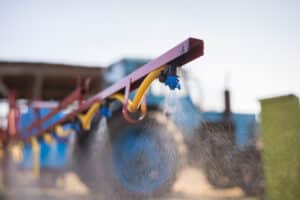
When fertilizer is applied to a field, it can provide an overabundance of nutrients like nitrogen and phosphorus. This impacts the microbiome because some beneficial microbes thrive in a balanced nutrient environment. Without the other nutrients they need, other microbes can outcompete them, disrupting your microbial diversity.
Some microbes are also especially sensitive to pH and salinity levels, and chemical fertilizers and pesticides can impact soil microbe growth, functions and abundance.
At their worst, since pesticides are designed to kill off pests, they can sometimes kill off-target beneficial fungi, bacteria, or protozoa.
Efficient nutrient source management is essential for healthy yields, healthy soil, and a healthy microbiome. When applying agricultural chemicals, consider the 4 Rs: right source, right rate, rate place and right time to get the most out of your applications while still supporting your soil health.

While it may seem advantageous from a process standpoint to only plant one kind of crop, this can leave your soil unhealthy and your microbes starving.
Planting the same crop each growing season means the soil nutrients needed by that crop are continuously absorbed at high levels. This creates an imbalance of nutrients. This then leads to nutrient deficiency and changes the soil microbiology.
At the rhizosphere, the root exudates can change the pH nutrient availability, C/N ratio and enzyme activity.
Your soil may experience a reduction in beneficial microbes and an increase in pathogens, which can cause serious soil-borne disease like root rot, nematode disease or damping-off.
When it comes to your crops, monocropping for extended periods of time can lead to slower plant growth, increased diseases, reduced yield and poor crop quality.

The weather is a variable that farmers have never had control over. We’re all at the mercy of precipitation and temperature. Yet, understanding how weather impacts the microbiome can help you understand what’s happening in your soil when you’re in a drought season, or if your fields are flooded.
Soil microbes respond to moisture availability and temperature. Drastic changes in moisture availability, in particular drought, impacts the microbiome by increasing osmotic stress and fluctuating accessibility to nutrients within the water film. Beneficial bacteria are most sensitive to fluctuations in water levels.
There’s also an ideal temperature range for microbial function. So, extremes on each side of the temperature spectrum impact microbial activity negatively. For example, with increased temperatures comes increased respiration rate. Microbes rapidly release CO2, CH4 and N2O from the soil. For every 10 degrees fahrenheit increase, activity doubles.
On the other hand, when temperatures drop below freezing, water inside the microbes can freeze and burst.
Elevated UV-B radiation can also decrease soil microbe populations.
If extreme weather trends continue, some experts believe this could make soil a carbon source rather than a carbon sink – further contributing to extreme weather fluctuations.
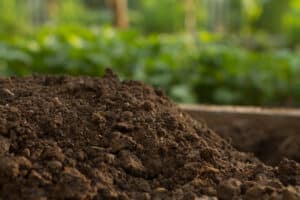
While it may feel discouraging that so many common practices negatively impact the microbiome – there is good news. Growers have a lot of control over their soil microbiome and can support beneficial microbes in numerous ways.
Crop rotation, leveraging the 4Rs, cover cropping, organic fertilizers, implementing low or no-tillage practices and feeding your soil microbiome are all soil building practices that positively impact biological communities.
They can then, in turn, support your soil health, crop health and yield potential.
Your impact on the microbiome from these practices will depend on the composition and activities of existing soil microorganisms, plus other soil characteristics. We always recommend performing a soil test, and working with a trusted agronomist or crop advisor to tailor your practices toward your unique soil, weather and crop planting.
Responsible nutrient management is ideal for supporting healthy soil and healthy yields. Applying agricultural chemicals means using the 4Rs to choose the right source, at the right rate, in the right place, at the right time.
Right source: When picking the right source, consider plant nutrient requirements, soil conditions, fertilizer delivery issues, environmental risks, price, economic constraints and how accessible the fertilizer and application tools are. All should be considered to make the most of an application.
Right rate: To pick the right rate, consider your yield potential, soil type, climate, economics, labor supply and logistics. Each site, crop and grower are different and play a role in determining the right rate.
Right place: No grower wants their investments to go to waste, which is why targeting nutrients in the right place is essential. Consider the nutrient source properties, crop needs, crop development and field management practices. For example, fertilizer applied directly to the root zone can increase nutrient uptake and reduce loss.
Right time: Like right place, right time can optimize nutrient uptake and minimize nutrient loss. Consider crop type, its needs, soil structure, nutrient retention capabilities and any climate impacts that could cause your application to go to waste.
Avoiding chemical applications is likely not an option for all growers, so when you are applying a product to your field, ensure you’re making the most of the application.

Cover cropping is beneficial to soil microbes because it enables you to keep a living root in the soil at all times. This provides additional nutrients for microbes. It also covers the soil, which can help you avoid wind and water erosion.
Picking the right cover crop to promote weed control, ease of termination, impact on soil temperatures and to support your cash crop is essential when cover crop planning. This extra effort and research can lead to notable yield differences as well as improved soil health.
Bare soils play a significant role in hurting the microbiome, so keeping roots in the ground is a best practice for supporting your soil microbes.
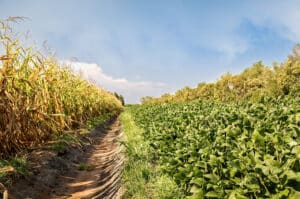
Like cover cropping, crop rotation can be beneficial to soil microbes as it adds to the nutrients available to them in your soil. At the end of their growing season, different types of residue are added to the soil, enhancing organic matter levels.
By mixing up the types of crops planted, you can also help keep pathogenic microbes and soil-borne diseases at bay, given that certain pests thrive under continuous cropping conditions. New crops support a more diverse microbial population and can aid in creating disease-suppressive soil.
Compost and manures can help provide your soil microbes with slow-release nutrients. These additives are tied to a carbon structure in which microbes control the release rate. As carbon is consumed, nutrients are released, which is essential to plant growth and development.
By adding compost and manures, you’ll be killing two birds with one stone, feeding beneficial microbes and your crops.
As outlined above, tillage can cause extensive damage to the microbiome. By disturbing your soil less and implementing a reduced or no-tillage practice, you can keep your microbe habitat intact.
Curious how big of an impact reduced or no-tillage could have on your soil? Start with a small trial before making a wide-spread change. It likely won’t be long before you start to notice a difference in soil quality and health.
Starving microbes need food they can access today. By applying a carbon microbial food source, like PhycoTerra or PhycoTerra Organic to your soil, you can feed beneficial microbes a balanced meal with microalgae. They can then get to work improving your soil structure, function, reducing plant stress and improving yield potential. After an application of PhycoTerra, most growers see up to a 33x increase in soil microbial activity.
When feeding soil microbes, look for products that are easy to use and can be added to an existing crop input and fertilizer application program. The product should have a high-mixability and long shelf life.
Curious to see trial results of a product like this across a wide range of crops? Check out our trial results data to explore the benefits of PhycoTerra.
While tillage, ag chemical use and monocropping is common on many farms, there are other integrated management strategies that can be implemented to support soil and microbiome health. Working with soil biology, in the long-run, has better return on investment and yield potential compared to the quick-fix offered by these solutions.
While new practices can be intimidating or cumbersome to start, protecting our soil health, quality, structure and biology goes a long way in supporting your farm for years to come. Consider moving away from harmful microbiome practices sooner than later.
Want to learn more about the impacts soil microbes have on your farm? Check out this video featuring our VP of Ag Science, Cassidy Million, where she covers How Microalgae is Transforming Soil Health.
Some common farming practices like tillage, excessive fertilizer and pesticide applications and monocropping can kill microbes in the soil. Extreme weather like droughts, temperature swings and flooding can also kill soil microbes.
There are lots of things that can affect the soil microbiome in positive and negative ways, like:
Microbial growth can be either positively or negatively impacted by many common practices used by growers.
For example, tillage can negatively affect microbial growth, as it destroys their native habitat, food source and can kill the current microbial population.
On the other hand, avoiding soil disturbance and providing microbes with a continuous food source can all aid their growth and support overall yield potential.
Yes, some practices can kill the microbes in your soil.